Wed 12 Dec 2007
The Compleat THORNE LEE, by Bill Pronzini.
Posted by Steve under Authors , Bibliographies, Lists & Checklists , Crime Fiction IV , Pulp Fiction[19] Comments
First — this is Steve — some background information and a bit of an introduction. If you were to look Thorne Lee up in either print or CD version of Crime Fiction IV, by Allen J. Hubin, his entry would look like this:
LEE, THORNE; pseudonym of Thornton Shiveley; Born in Nebraska; in 1950s living in California and instructing in English and speech at a junior college; actor; writer under another name.
The Monster of Lazy Hook (Duell, 1949, hc) [California]
Summer Shock (Abelard-Schuman, 1956, hc) [Oregon]
or at least that’s how it appeared until Al sent me an update for him in Part 9 of the Revised CFIV. Not much, but at least an approximate year of birth for him:
LEE, THORNE. Thornton P. Shiveley, ca.1874- .
Following this, several months later, Al sent me an update correcting the spelling of the author’s last name, saying “There’s a Thornton P. Shively in the Mormon site with the right birth date, so I assume it’s he.”
If he was born in 1874 would have made him a little old to be teaching in the 1950s, but that’s hardly impossible.
But while doing a search for Lee on the Internet, I found an eBay seller who was offering a signed copy of The Monster of Lazy Hook. As part of the description she said, “Inscribed and signed on copyright page by author both as ‘Thorne Lee’ and Thornton T Shiveley.”
So we’re back to Shiveley, but where did the middle initial “T” come from?
We asked Victor Berch, who replied with the definitive answer. Al, this time, had the wrong fellow. Said Victor, “From what I can determine, Thornton T. Shively was the son of Thornton P. Shively. In the 1930 Census, he was listed as 17 years old, born in Nebraska.. His father Thornton Pickenpaugh Shively was an accountant, born in Virginia. Thornton T. was born Feb. 26 1913 in Nebraska and died June 21, 1980 in Santa Cruz, CA.
And as an immediate consequence, the basic online entry for Lee/Shively now looks like this:
LEE, THORNE. Pseudonym of Thornton T. Shively, 1913-1980.
In the meantime I’d discovered that Lee had written extensively for the pulp magazines, so I sent this information on to Bill Pronzini. At the same time I asked if had copies of both of Lee’s books, and whether he’d read either of them. Indeed he had, and I’ll let him take over from here:
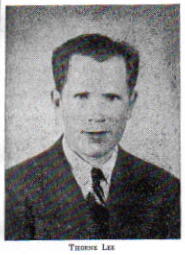
He began writing during WW II. His first novel, The Fox and the Hound, about an amnesiac trying to find out who he is and whether or not he committed murder, was published complete and unabridged in the August 1944 issue of Mammoth Detective (from whence came the author’s bio below). Unlike some of other full-length novels which first appeared in the Mammoth mags, it was never published in book form. From 1944 to 1949 he contributed more than 30 tales to Black Mask, Dime Detective, New Detective, Doc Savage, The Shadow, S&S Detective Story, Ten Detective Aces, and other pulps. He also wrote a few stories for the sf mags of the period.
In Thorne Lee’s own words:
Peering into the remote and shady past of a mystery writer, you might expect to find a witches’ brew of dangerous living and dark adventure, but my own life story reads more like an afternoon recital at a ladies’ garden party. Any resemblance to excitement in my tales is purely accidental — or I should say, purely imaginary. I have yet to look down the wrong end of a gun barrel — which is probably true of a lot of fire-breathing yarn-spinners. Well, we can’t all be Jack Londons.
“Born in Nebraska, married in Montana, and a daddy in Southern California” covers the high spots for me. I think my first interest in words began with a story called the The Enchanted Isle of Yew. That was all I read — just the one book, over and over. So far I haven’t been accused of writing the same story over and over, but I suppose that will come in time.
I first looked on writing with professional intent while editing a college weekly. About that time I wrote a musical comedy (book and lyrics) and was ruined for life. The show was one of those “local boy” affairs with a fat part for myself. On the road it ran four solid nights. I think the lyrics are funny, but for a different reason.
That brief fling as a Main Street Noel Coward plus an after-dinner speaking contest gave me the quaint idea that I should be a magazine humorist. Ha! ha!
… I topped off college graduation with a year in university theatre, where I almost flunked in playwriting. For a brief time I wavered between acting and free-lance writing. The choice was easy; chances were that either career I chose would be the wrong one.
Since then I’ve worked as everything from chauffeur to night clerk, to florist, to meter reader. So far I’ve managed to leave all jobs under my own power. A brief career as a school teacher was soon abandoned. The last straw was the day a tenth grader mistook me for a fellow pupil.
I write mystery stories for three reasons: (1) I like to read them; (2) a good share of the better writing being done (setting my own stuff tenderly aside) can be credited to mystery writers; (3) my first stories sold were mysteries.
My own reading tastes vary widely from Hilton to Hammett. I like my share of realism, but I don’t favor the theory that the supernatural and abnormal are out-of-date in mystery writing, or ever have been since Poe.
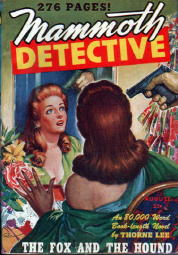
The Fox and the Hound is my first novel. I use a pseudonym for the reason that my own name is invariably misspelled or mispronounced, or both. Thorne Lee is an abbreviation based on the first and last syllables of my name.
I like to work in old, ragged clothes. As a writer I have found that desire easy to satisfy. My wife, Betty, says I am probably the only scarecrow to write a novel.
I’ve been falsely accused of favoring red-headed heroines because my four-year-old daughter, Susan Leigh, has golden red hair.
Our home is that place they write songs about, the San Fernando valley. I am working in an essential industry until the end of the war gives me “time to retire,” or until Uncle Sam looks with favor upon my bony physique. Even now I think I hear the old gentleman mumbling my name. Perhaps I’ll have that real-life adventure after all. If so, I know there will be a lot of good fellows with good intentions sharing that adventure.
The series of stories featuring the detective duo of crippled Julian Renard and his Watson, Roger Bannister, appeared solely in Doc Savage, 1945-47. Here’s the complete list, with issue dates
“The Shock Punch” — June 1945
“The Britannica Sock” — January 1946
“Who Rides a Tiger…” — April 1946
“The Man Who Got Away With It” — August 1946
“The Monster of Lazy Hook” — December 1946
“There Was an Old Shoe” — May-June 1947
“The Woman in the Attic” — July-August 1947
“The Ghost Hangs High” — September-October 1947
Thorne Lee also wrote a couple of pretty good hardcover mysteries:
THE MONSTER OF LAZY HOOK (Duell, Sloan & Pearce, Inc.: A Bloodhound Mystery; 1949) is a much altered expansion of the short story of the same title and features Renard and Bannister.
From the blurb on the inside jacket flap:
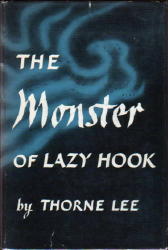 In swift succession, three men — all leading citizens of the little California coastal town of Lazy Hook — vanished without a trace. All three had been connected with the late Spencer Van Dyke, eccentric millionaire, who though he died of natural causes had managed to surround his death with many-sided mystery. What had Spencer Van Dyke done with the huge sum of cash withdrawn from his bank shortly before his death? What was the meaning of the fantastic poem he caused to be engraved on his marble gravestone? Why had he bequeathed the vast and dilapidated Van Dyke mansion to his hermit butler? Had he come from beyond the grave to spirit away Lyman Hobbs, his undertaker, Henri Picard, his lawyer, and Peter Ramsey, the local editor?
In swift succession, three men — all leading citizens of the little California coastal town of Lazy Hook — vanished without a trace. All three had been connected with the late Spencer Van Dyke, eccentric millionaire, who though he died of natural causes had managed to surround his death with many-sided mystery. What had Spencer Van Dyke done with the huge sum of cash withdrawn from his bank shortly before his death? What was the meaning of the fantastic poem he caused to be engraved on his marble gravestone? Why had he bequeathed the vast and dilapidated Van Dyke mansion to his hermit butler? Had he come from beyond the grave to spirit away Lyman Hobbs, his undertaker, Henri Picard, his lawyer, and Peter Ramsey, the local editor?
These were the questions that were thrust at the strange pair of detectives who set out to solve the apparently insoluble. The two, crippled Julian Renard, mostly brains, and Robert Bannister, mostly brawn, found themselves in a peculiar and dangerous setup, and only their assorted but well-balanced gifts, together with a certain bit of luck, brought them through alive and entitled to the rewards they had been promised.
Thorne Lee’s is a fast-paced puzzler, with enough easy humor and unexpected romance to balance the grim and inevitable drama that envelops Lazy Hook and its citizens.
SUMMER SHOCK (Abelard-Schuman Ltd., 1956) is a good, unusual suspense novel that takes place at the Ashland, Oregon Shakespeare Festival (which is still being held annually and draws huge crowds). According to the author’s bio on the jacket, Shively acted in numerous plays put on at the festival, among them Richard II and King Lear. At the time the book was published he was living in Visalia, CA. and teaching at College of the Sequoias.
Once again, from the blurb from the inside jacket flap:
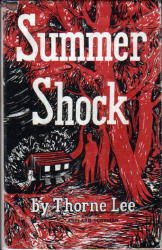 The very first reader of this book, when it was in manuscript form, started his report with this sentence: “This is a book that I don’t think you should get away from you.” We feel that the readers of the finished book will feel the same way about it.
The very first reader of this book, when it was in manuscript form, started his report with this sentence: “This is a book that I don’t think you should get away from you.” We feel that the readers of the finished book will feel the same way about it.
The Pacific Northwest is the setting, and the author’s description of the natural scenery and his use of it in the story, add much to the special flavor of the novel. The characters are all member of a semi-professional group of actors engaged in putting on a Summer Shakespearean festival. The theatrical background is completely authentic and the details of casting for the various plays are cleverly woven into the plot. (The theatrical material is completely fascinating in itself, but never gets in the way of the swiftly moving story which is full of suspense.)
It is impossible to summarize the plot without detracting considerably from the reader’s enjoyment — except to say that it is a psychological-suspense story. There are several murders, but this is not a murder-mystery. The reader can be fairly sure, from the very beginning, as to the identity of the murderer. It is the development of the murderer’s mental processes, and the effect this has on all the people around him, that holds our interest.
ADDITIONAL BIBLIOGRAPHY: PULP FICTION —
From the Cook-Miller index to Detective Pulps, along with Science Fiction, Fantasy, & Weird Fiction Magazine Index (1890-2006) by Stephen T. Miller and William G. Contento for the SF, plus a big assist from Victor Berch:
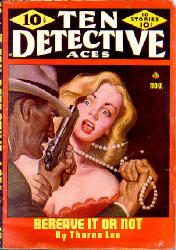
The Blood Runs Cold, Doc Savage, Sep 1948
The Britannica Sock [Bannister & Renard], Doc Savage, Jan 1946
A Corpse Slept Here, Dime Detective, Dec 1947
The Crooked House, Weird Tales, Nov 1942 [not by Thorne Lee; see the comments]
Dance Macabre, Ten Detective Aces, Mar 1948
Dead to the World, Ten Detective Aces, Nov 1947
Deadbeat, Doc Savage, Nov 1946
Death in the Groove, Dime Detective, Mar 1946
Dragnet for a Spy, FBI Detective Stories, Oct 1950
Dying to Kill, New Detective Magazine, Sept 1946
The Face of Fear, New Detective Magazine, July 1947
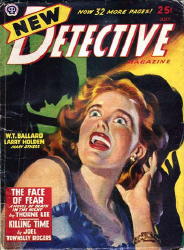
The Flesh Is Willing, Doc Savage, July 1946
The Fox and the Hound, Mammoth Detective, Aug 1944
The Ghost Hangs High [Bannister & Renard], Doc Savage, Sep-Oct 1947
Ghost Planet, Startling Stories, June 1943 [probably not by Thorne Lee; see the comments]
The Hanging Sisters, Chief Detective, Winter 1946
Headless Horseman, The Shadow, Aug 1945
I Thought I’d Die, New Detective Magazine, Mar 1946
If Anything Happens to Julia, Shadow Magazine, Feb-Mar 1948
It’s Been a Long, Long Crime, New Detective Magazine, July 1946
It’s in the Bag!, Dime Mystery, Mar 1947
Laughing on the Outside, Detective Story Magazine, Aug 1947
The Mad Dog of Lame Creek, Black Mask, Mar 1946
The Man Who Got Away with It [Bannister & Renard], Doc Savage, Aug 1946
The Man Who Lost His Shadow, Fantastic Adventures, June 1944
Married to Murder, Dime Detective, May 1947
The Merry Men of Mayhem, Detective Tales, Dec 1946
The Merry Widow Murder, Detective Book Magazine, Fall 1949
The Monster of Lazy Hook [Bannister & Renard], Doc Savage, Dec 1946
Murder on My Shoulders, New Detective Magazine, Mar 1947
The Mutilator, Detective Book Magazine, Sum 1949
No Body But Me!, New Detective Magazine, Jan 1947
Possession, Shadow Mystery, Fall 1948
The Reluctant Leopard, Doc Savage, May 1945
The Shock Punch [Bannister & Renard], Doc Savage, June 1945
Some Call It Murder, Detective Story Magazine, Aug 1946
Stairway Going Down, Dime Detective, Sept 1945
There Was an Old Shoe [Bannister & Renard], Doc Savage, May-June 1947
The Whisperer, Dime Detective, Mar 1945
The Whispering Wine, Weird Tales, Mar 1943 [not by Thorne Lee; see the comments]
The Will to Die!, Dime Detective, Apr 1951
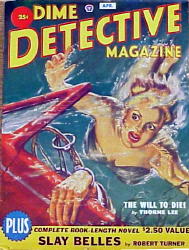
Who Rides a Tiger… [Bannister & Renard], Doc Savage, Apr 1946
The Woman in the Attic [Bannister & Renard], Doc Savage, July-Aug 1947
December 12th, 2007 at 6:06 pm
Thanks Steve, excellent comments on Thorne Lee by you and Bill Pronzini. A few years ago I noticed that his short stories were fine examples of hard-boiled fiction and for several weeks I read one each day at lunch time. His best work appeared in the Popular Publication pulps like Black Mask, Dime Detective, New Detective, Detective Tales. It’s amazing how many pulp stories you can read over a 40 year period if you read a two or three each day. Even at only 1,000 a year that adds up to 40,000 stories.
December 12th, 2007 at 6:34 pm
Walker,
Well, of course we agree on this. Even the lesser known writers for the pulps, especially ones like Thorne Lee who hung around for a while, had a lot to offer, and if you can hunt them down, they still have what it takes. Story tellers, they were, first and foremost.
But as for how many pulp stories you can read in a lifetime, you do have to start at a young age, don’t you? Say around 65, or before?
Steve
December 13th, 2007 at 10:45 am
Very interesting. Always wondered about Lee. Clearly, his Renard (Fox) and Bannister stories are meant to evoke Nero Wolfe and Archie Goodwin.
–Will
December 13th, 2007 at 4:31 pm
Will
Here’s Bill’s reply. Quite obviously you’re correct. I wonder if anyone’s made a list of all of the detective duos based on Wolfe and Goodwin. Would you say that D. L. Champion’s Inspector Allhoff stories were also, in a particularly perverse sort of way? — Steve
>>>>>>>>>>>>>>>>>>>>>>>>>>>>>>>>>>>>>>>>>>>>>>>>>>>>>
Steve:
I think it’s safe to say that Renard/Bannister were inspired by Stout and intended to be pulp versions of Nero and Archie. The main differences are that the byplay between Lee’s characters isn’t nearly as witty, and Renard, despite being crippled and confined to a wheelchair, gets out and about often with Bannister’s help and does much of his detecting on scene.
Best,
Bill
December 13th, 2007 at 6:06 pm
While discussing Inspector Allhoff further with Will, I came across the Thrilling Detective website, where there’s an entry on him. I haven’t read any of them in a while myself, but the characters if not the stories have stuck with me.
Here’s what Kevin Burton Smith has to say, and I’m quoting:
“Not quite a P.I., not quite a real cop, INSPECTOR ALLHOFF is actually a member, albeit unofficially, of the NYPD. He works out of a cockroach-infested dump, across the street from headquarters, swilling coffee, refusing to leave the apartment. And he’d prefer it that way. He’d rather work independently of the department, ever since he lost his legs while leading a botched police raid.
“Rather than lose a brilliant, if arrogant, detective, the commissioner has set up Allhoff as kind of free-roving, unofficial homicide inspector, and assigned him two other policemen to do his legwork. And there’s the rub: one of the officers assigned to Allhoff is the rookie responsible for the screwed-up raid. Allhoff, bitter, possibly no longer even stable, delights in tormenting young Battersly, who’s already wracked with guilt. And the other officer, an older man, Simmonds, riding out his pension, is forced to bear witness to Allhoff’s nasty psychological warfare.
“What seems at first glance to be a variation on Nero Wolfe turns out to be an amazing character study of possibly the world’s first ‘sadomasochistic detective team.’ There were twenty-nine stories in the series in all, regularly published in the pages of Dime Detective from about 1938 until 1946, and despite the rather disturbing relationship between the lead characters, the stories are a blast to read, and some of them are a downright hoot.”
Kevin goes on to say that many of the tales were of the locked-room variety. Time to dig out my issues of Dime Detective, that’s all there is to it.
December 14th, 2007 at 5:06 pm
In addition to the excellent Inspector Allhoff series in Dime Detective, D. L. Champion also had the crazy Rex Sackler, the penny pinching private eye, series running in Black Mask. These stories I found to be hilarious and just as much fun to read as Inspector Allhoff. So I recommend you dig out your issues of Black Mask also.
December 14th, 2007 at 9:36 pm
Walker,
Yes, I remember the Sackler stories, or at least I remember Sackler. He had an assistant named Joey something, didn’t he? If I’m right, that would put them into the same category of reverse take-off’s on the Wolfe-Goodwin concept as Allhoff & Battersly.
— Steve
December 14th, 2007 at 11:58 pm
Yes, Rex Sackler had an assistant named Joey who narrated the stories. Also for those readers who made the mistake of not collecting Dime Detective, the Inspector Allhoff stories have been reprinted in a large paperback titled, “Footprints on a Brain.” Amazon has copies for sale.
July 12th, 2008 at 9:52 am
I need to point out an error in your listing for Thorne Lee…. namely the two stories published in Weird Tales… those were not by Thorne Lee, but by ‘Thorne Lee Jr.’ a pen-name of my father, Laurence J. Buman. He usually went by Garson L. Thorne, but the publisher of Weird Tales told him it was Too long of a name, and changed it to Thorne Lee Jr.
July 12th, 2008 at 10:38 am
My father also mentioned a third story that he sent for submission just before he went into the army. He was never sure if that story got published or not… This could be the ‘Ghost Planet’ story that is mentioned as published in Startling Stories, June, 1943. I am excited about this, because it could very well be the missing story!! Also, if you look at the date of his first novel, being 1944, and the other stories all being 1944 or later, the three pre-44 stories don’t fit in.
July 12th, 2008 at 6:08 pm
Robert
Thanks for letting me know about the errors — very much appreciated! I’m sure you’re correct. I’ve added a note for all three in the bibliography above.
Best
Steve
March 26th, 2009 at 12:29 pm
Did Mr. Thorne Lee write any non-fiction articles for any magazines and if so would you know which ones?
August 17th, 2010 at 3:50 pm
Steve: My parents were frinds of the Shivelys in Ashland Oregon in the mid-40s, corresponded with them as late as 1959. I am now going through my late father’s letters and pictures, including at least some from the Shivelys. Do you have any contact with their children (Susan, Sally)? I’d like to find out more about their later lives.
August 17th, 2010 at 4:11 pm
Jack
I’m sorry I missed your comment until now, but no, I have no information about Lee’s non-fiction articles, but chances are good that he did do some.
George
No, I wish I could help you track down the Shively children, but right now, the article above is all the information I have.
Do you have any photos of Thornton, especially any where he’s working at a typewriter or as a writer?
— Steve
October 31st, 2010 at 2:22 am
Dear Walker,
Could you tell me exactly how many Inspector Allhoff’s stories there were in DDM all total? I own the Footsteps on a Brain series.
Thank you.
October 31st, 2010 at 5:04 pm
According to Walker’s article on DIME DETECTIVE, which you can read here: https://mysteryfile.com/blog/?p=4814
there were 29 Allhoff stories.
— Steve
January 25th, 2012 at 11:04 am
Thank you so much for posting this information. I used it in my blog today: http://bethzare.wordpress.com/2012/01/25/grandpa-shively/
I am Thornton Shively’s eldest grandchild. He would have been tickled pink to know so much was being written and said about his work.
Please feel free to contact me with any questions about the family.
January 25th, 2012 at 1:45 pm
Beth
It’s good to know that the information we found out about your grandfather was useful to you. The photo of him on your blog was also nice to see. It sounds as though you have good memories of him!
— Steve
December 25th, 2022 at 2:21 am
[…] about this author’s work on MysteryFile, including some nice comments. Basic biographical […]